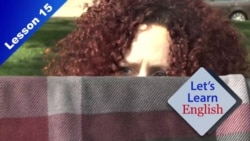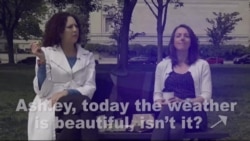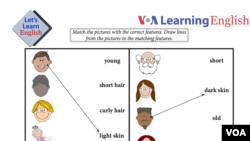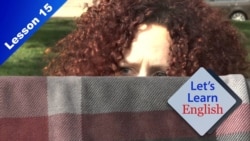Lesson 15: I Love People-Watching!
Let’s Learn English เปิดโอกาสการเรียนรู้และฝึกทักษะภาษาอังกฤษ ในรูปแบบที่ถูกออกแบบโดยผู้เชี่ยวชาญตามมาตรฐานการศึกษาของอเมริกา เพื่อให้เนื้อหาเหมาะสำหรับผู้เริ่มเรียนภาษาอังกฤษ
เรานำเสนอ 52 บทเรียน และทุกๆ 5 บทเรียน จะมีการทบทวนสิ่งที่เรียนไปแล้ว
ทุกสัปดาห์จะมีบทเรียนใหม่ พร้อมด้วยวิดีโอ ที่สะท้อนชีวิตชาวอเมริกันรุ่นใหม่ ผู้เรียนจะได้ฝึกการพูด เขียน และจดจำคำศัพท์
นอกจากนั้นผู้เรียนสามารถพิมพ์บทเรียนที่ทำแล้ว ผลการฝึกฝน และแผนการฝึกเรียนภาษาอังกฤษในบทต่อๆ ไปได้
เราอยากให้คุณติดตามบทเรียนใหม่ๆ ทุกสัปดาห์ และบอกให้เรารู้ถึงการเรียนรู้ของคุณผ่านการแสดงความคิดเห็น (comment) และอีเมล์ของเราที่ thai@voanews.com
เรื่องย่อ
แอนนาและเพื่อนของเธอออกมารับประทานมื้อเที่ยงนอกที่ทำงาน เพื่อชมบรรยากาศในกรุงวอชิงตัน และพวกเธอชอบมองผู้คนเดินผ่านไปมาเสียเหลือเกิน
ฝึกพูด
ในวิดีโอนี้ คุณจะได้เรียนรู้คำศัพท์ใหม่ๆ ได้รู้จักเสียงที่แสดงอารมณ์ของความสุขในภาษาอังกฤษ คุณสามารถดาวน์โหลด เอกสารประกอบการเรียน และร่วมฝึกการพูดอธิบายลักษณะท่าทางของผู้คนกับเพื่อนๆได้
ฝึกออกเสียง
ในวิดีโอนี้ คุณจะได้เรียนรู้เรื่องประโยคคำถามแบบย่อ หรือ Question Tag ที่จะใช้ลงท้ายประโยดบอกเล่า เพื่อย้อนถามคู่สนทนาในสิ่งที่พูดไปก่อนหน้านั้น อย่างในเรื่องนี้ได้ถามว่า "It's a beautiful day, isn't it?" ซึ่งหมายความว่า "วันนี้อากาศดีใช่ไหม?"
บทสนทนา
Anna: Hello! People from all over the world come to Washington, D.C. When I’m at work, I love eating lunch outside. I like to watch people walking by. They all look very different. Today, my friend Ashley is eating lunch with me.
Anna: Ashley, today the weather is beautiful, isn’t it?
Ashley: Yes, it is. Ahh. Ooh, we have to return to work!
Anna: No, we have time! Let’s people-watch a little more.
Ashley: Okay.
Anna: Oh, I know her. She works in my office! Keyana, hi! Come and join us!
Keyana: Hi Anna, how are you?
Anna: I’m doing great! Keyana, this is my friend Ashley.
Keyana: Hi, Ashley!
Anna: We need to return to work. But the weather is beautiful and people-watching is fun!
Keyana: I love people-watching too!
Anna: Well, have a seat! It is fun to see how people are different or the same.
Keyana: It is. For example, Anna, you are tall. But Ashley and I are short.
Anna: And Keyana, you and Ashley have brown eyes; I have blue eyes.
Keyana: You two have light skin and I have dark skin.
Anna: Ashley, you have straight hair. Keyana and I have curly hair.
Ashley: You have very curly hair, Anna.
Keyana: I need to return to work. See you, Anna! Nice to meet you Ashley!
Ashley: Bye, Keyana!
Ashley: Anna, I have to go, too. Are you returning to work?
Anna: I still have time. And this sun feels so good!
Ashley: Um, Anna, what does your boss look like?
Anna: She is short. She has straight, light hair.
Ashley: Does she wear glasses?
Anna: Yes. Yes, she does.
Ashley: Is she wearing a blue sweater today?
Anna: How do you know that?
Ashley: She’s coming this way.
Anna: Oh no! Hide me!
Ashley: Um, bye, Anna. Call me later.
Anna: Bye, Ashley! Talk to you later!
Caty: Anna? Is that you?
Anna: Ms. Weaver! Hi!
Caty: What are you doing behind that bench?
Anna: I am looking for my, my … stick. Here it is.
Anna: I am people-watching. Oh! But it’s time to return to work!
Caty: No need to hurry. I love people-watching too! Let’s sit!
Anna: Sure! Ahh.
Caty: It’s a beautiful day, isn’t it?
Anna: Yes. Yes, it is, Ms. Weaver.
Anna: People-watching in D.C. is fun. It makes me forget the time!
Anna: Until next time! Ahh.
ฝึกเขียน
แล้วคุณหน้าตาเป็นอย่างไร? แล้วเพื่อนของคุณเป็นอย่างไร? เขียนอีเมลหาเรา หรือเขียนในช่องแสดงความเห็น (Comment) ด้านล่าง
คลิกที่ภาพด้านล่าง หรือคลิกที่ เอกสารประกอบการเรียน เพื่อฝึกฝนกับเพื่อนได้
กลยุทธ์การเรียนรู้แบบลัด
Learning Strategies หรือ กลยุทธ์การเรียนรู้ คือความคิด ความตั้งใจ และการกระทำ ที่ช่วยให้การเรียนง่ายขึ้น หรือมีประสิทธิภาพมากขึ้น
กลยุทธ์การเรียนรู้ของตอนนี้ คือ การเข้าถึงแหล่งข้อมูล (Access Information Sources)
อย่าลืมว่าในโลกดิจิทัล เราสามารถค้นหาข้อมูลเพื่อทำให้เรียนรู้ภาษาอังกฤษได้มากมาย และอย่าลืมว่าคนรอบข้างก็ช่วยให้คุณเรียนรู้ภาษาอังกฤษได้เช่นกัน
แล้วคุณใช้กลยุทธ์การเข้าถึงแหล่งข้อมูลในการเรียนรู้ภาษาอังกฤษบ้างหรือไม่? เขียนหาเราในช่องแสดงความเห็น หรือ อีเมลหาเรา
สำหรับครูผู้สอน คลิกที่ Lesson Plan เพื่อดูกลยุทธ์การสอนในบทเรียนนี้
ทดสอบความเข้าใจด้วยการฟัง
ทดสอบว่าคุณเข้าใจบทเรียนมากเพียงใด ด้วยการทำแบบทดสอบนี้ เล่นคลิปวิดีโอและเลือกคำตอบที่ถูกต้อง
Quiz - Let's Learn English Lesson 15
Start the Quiz to find out
______________________________________________________________
คำศัพท์ใหม่
bench - n. a long and usually hard seat for two or more people
blue - adj. having the color of the clear sky
brown - adj. having a color like coffee or chocolate
curly - adj. formed into a round shape
dark - adj. of a person's hair, eyes, skin, etc.: black or brown in color
eyes - n. the part of the body that you see with
forget - n. to be unable to think of or remember (something)
glasses - n. a pair of glass or plastic lenses set into a frame and worn over the eyes to help a person see
hair - n. a thin threadlike growth from the skin of a person or animal
hide - v. to put (something) in a place where it cannot be seen or found
join - v. to come together with (something or someone)
light - adj. not dark or deep in color; pale
like - prep. similar to
look like - to have an appearance that is very similar to (someone or something)
people-watch - v. to spend time idly observing people in a public place.
seat - n. something (such as a chair) that you sit on : a place for sitting
have a seat - a polite invitation to sit down.
short - adj. having little height; not tall
skin - n. the natural outer layer of tissue that covers the body of a person or animal
stick - n. a cut or broken branch or twig
straight - adj. not having curves, bends, or angles
tall - adj. greater in height than the average person
______________________________________________________________
เอกสารประกอบการเรียน
ดาวน์โหลด VOA Learning English Word Book ซึ่งเป็นเอกสารรวมคำศัพท์ที่ใช้ในเว็บไซต์นี้
ในแต่ละบทเรียนของ Let’s Learn English เรามีชุดฝึกทบทวน Activity Sheet สำหรับการฝึกเพิ่มเติมที่คุณทำได้เอง
สำหรับครูผู้สอน
คลิกที่ Lesson Plan ในบทเรียนนี้ เพื่อเป็นแนวทางในการเรียนการสอนในห้องเรียนของคุณ หรือ อีเมลหาเรา หากมีคำถามหรือคำแนะนำในหลักสูตรนี้
ไวยากรณ์ที่ควรใส่ใจ
คำคุณศัพท์เพื่อใช้อธิบาย และประโยคคำถามอย่างย่อ (Question Tag)
หัวข้อหลักในบทนี้
การอธิบายความเหมือนและความแตกต่าง การสังเกตผู้คน
กลยุทธ์การเรียนรู้แบบลัด
การเข้าถึงแหล่งข้อมูล (Access Information Sources)
การฝึกพูดและการออกเสียงที่ควรใส่ใจ
อวจนะภาษาเพื่อแสดงถึงความรู้สึกมีความสุข การออกเสียงสูง-ต่ำ ในประโยคคำถามอย่างย่อ
______________________________________________________________
ตอนนี้คุณสามารถบอกเราได้ว่าคุณคิดอย่างไรกับบทเรียนนี้ ด้วยการเขียนอีเมลหาเรา หรือแสดงความคิดเห็นมาที่ช่องแสดงความคิดเห็นด้านล่าง หรือส่งมาทางหน้า Facebook












